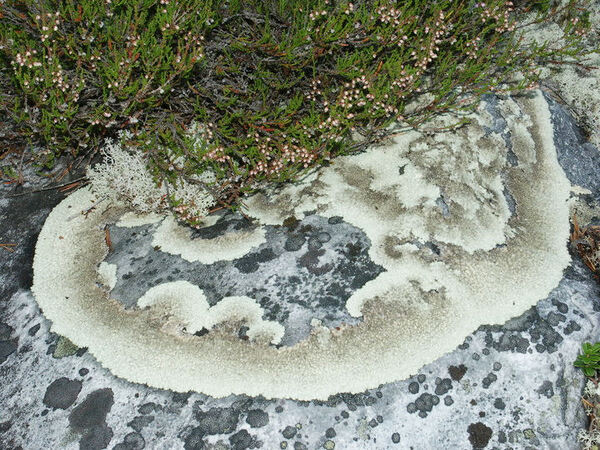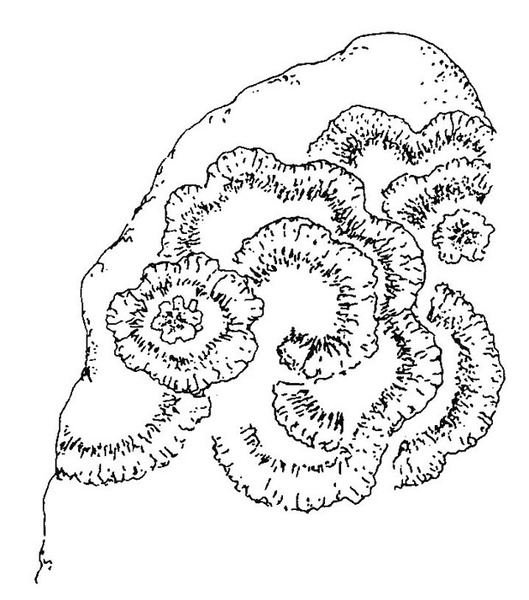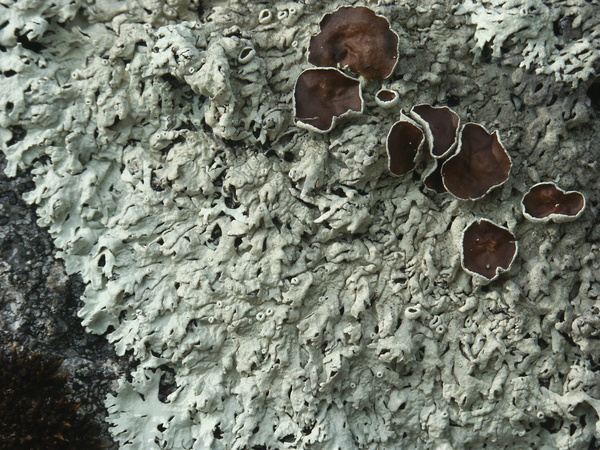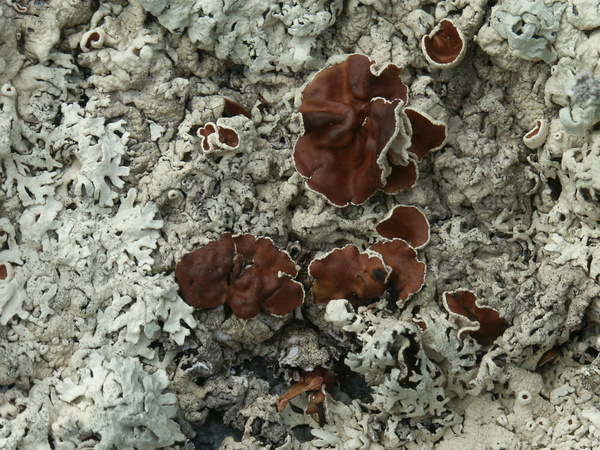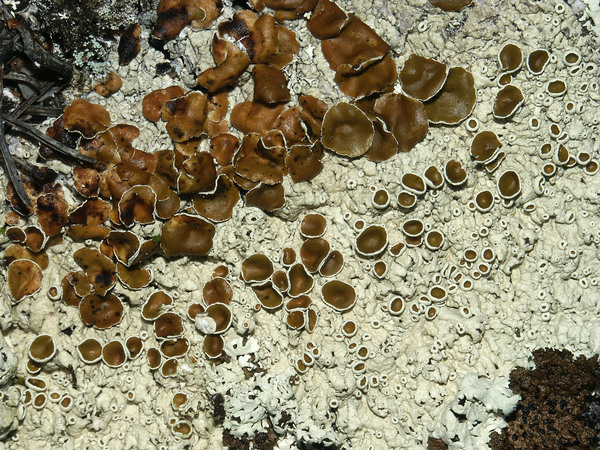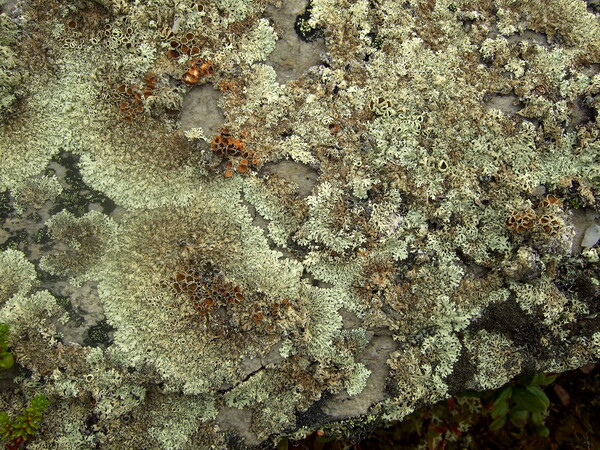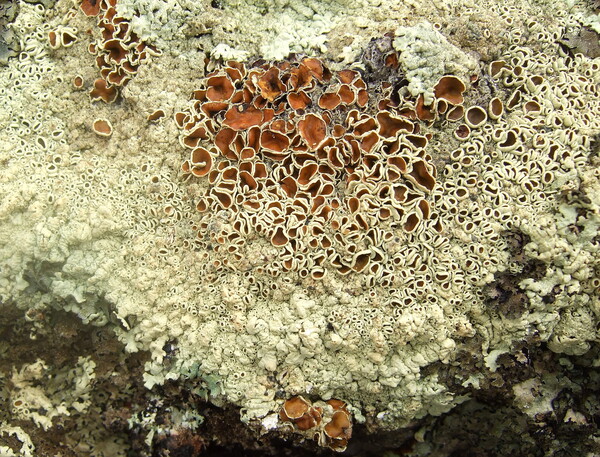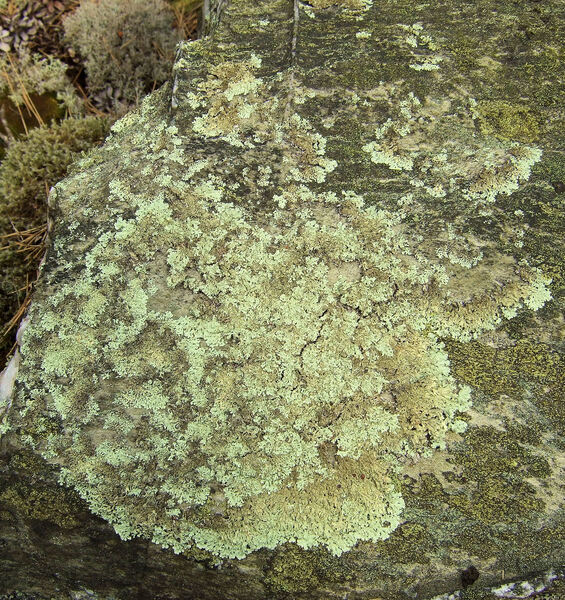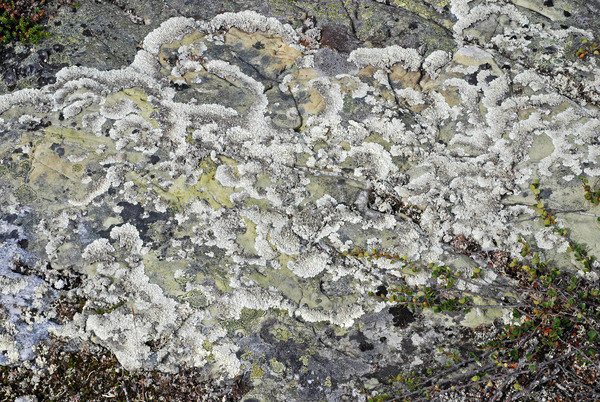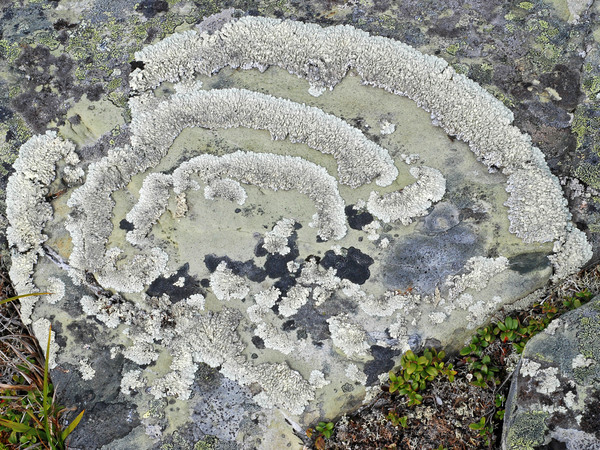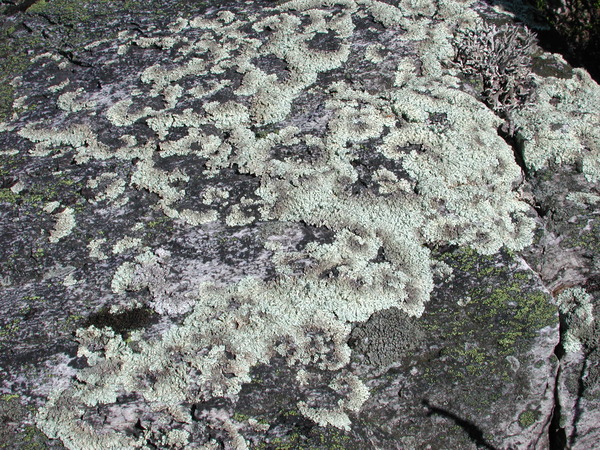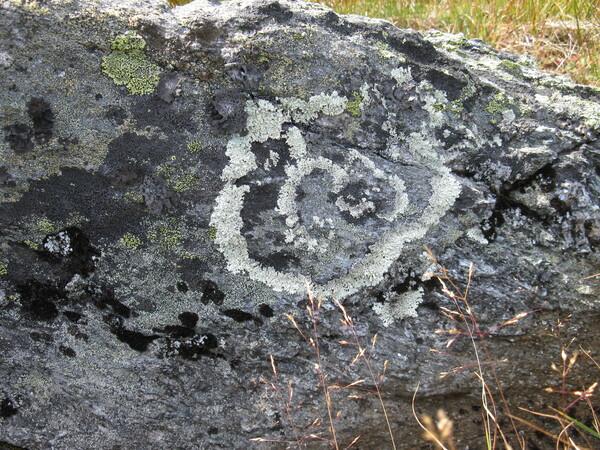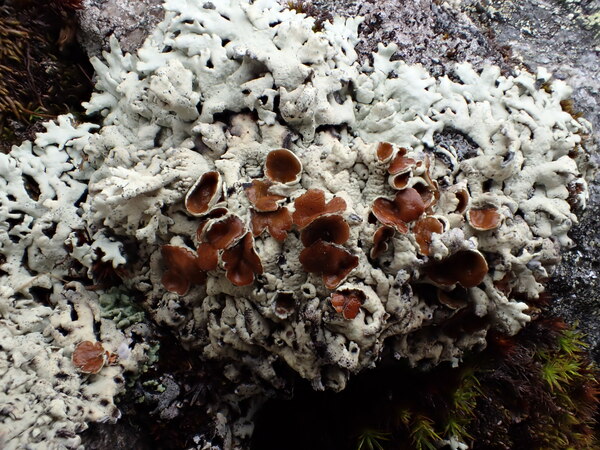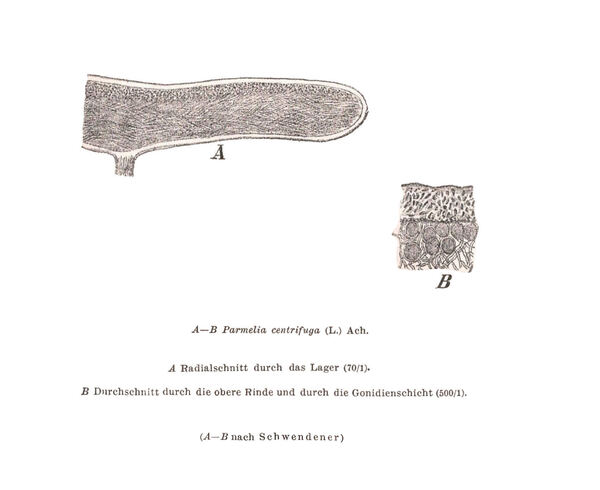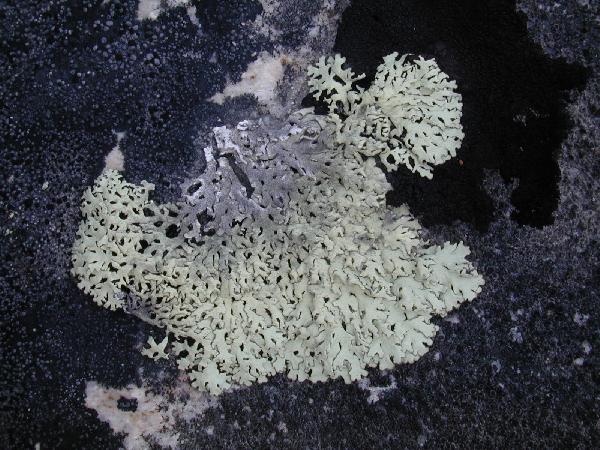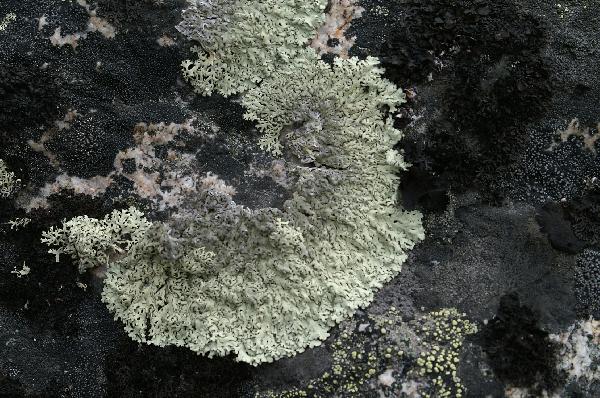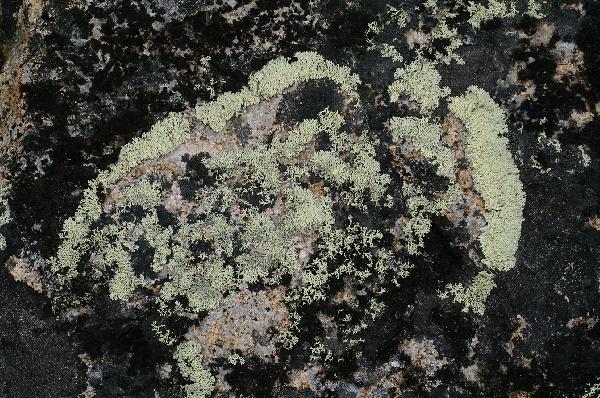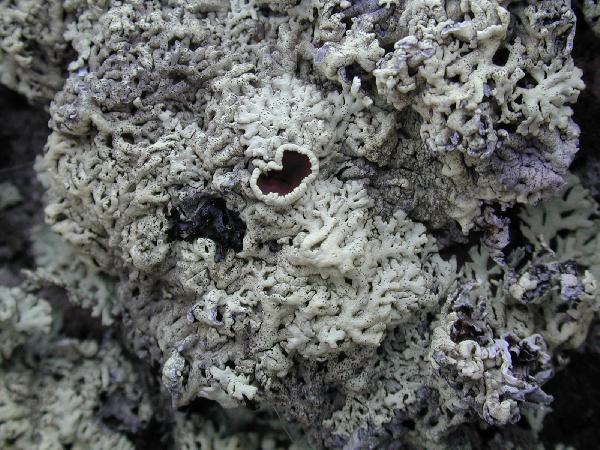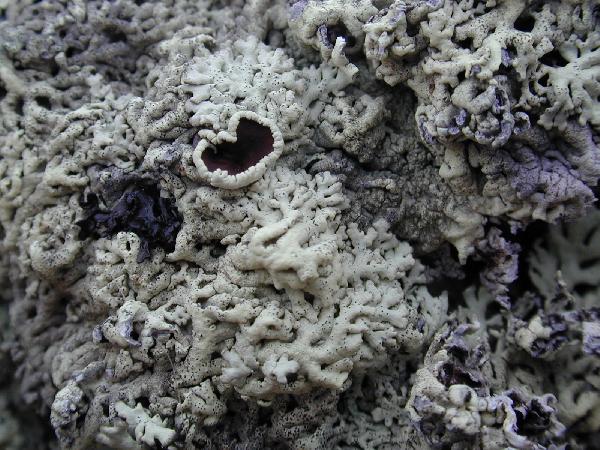Arctoparmelia centrifuga (L.) Hale
Mycotaxon, 25: 252, 1986. Basionym: Lichen centrifugus L. - Sp. Pl., 2: 1142, 1753.
Synonyms: Parmelia centrifuga (L.) Ach.
Distribution: N - Ven, Piem.
Description: Thallus foliose, heteromerous, dorsiventral, closely adnate, dying in the center and forming concentric rings which can reach almost 1 m in diameter. Lobes irregularly branched, flat to slightly convex, 1-2 mm broad, with pointed tips, the upper surface greenish yellow or partly whitish green, darkening toward center, the lower surface whitish or pale brown, with sparse, brown to blackish rhizines. Upper cortex of tightly packed, anticlinally oriented hyphae, with a pored epicortex, the cell walls with Cetraria-type lichenan; medulla white, not amyloid; lower cortex appearing velvety due to minutely papillose, projecting hyphae. Apothecia lecanorine, laminal, adnate, to 5 mm across, with a reddish brown to dark brown disc and an entire to crenulate, sometimes inflexed thalline margin. Epithecium brown; hymenium colourless, I+ blue; paraphyses sparingly branched, the apical cells slightly swollen; hypothecium colourless. Asci 8-spored, clavate, the K/I+ blue tholus penetrated by a faintly amyloid apical cushion with parallel or diverging flanks, the wall K/I-, surrounded by a K/I+ blue outer layer, Lecanora-type. Ascospores 1-celled, hyaline, ellipsoid, 8-14 x 4.5-6 µm. Pycnidia frequent, laminal immersed. Conidia slightly dumbbell-shaped 5-7 x c. 1 µm. Photobiont chlorococcoid. Spot tests: cortex K+ yellow, C-, KC-, P-; medulla K-, KC+ red, P-, UV+ glaucous blue. Chemistry: cortex with usnic acid and atranorin; medulla with alectoronic acid.Note: an arctic-alpine lichen of exposed siliceous rocks near or above treeline, certainly very rare in the Alps (Austria). Italian records need confirmation (see Nimis 1993: 490).
Growth form: Foliose, narrow lobed
Substrata: rocks
Photobiont: green algae other than Trentepohlia
Reproductive strategy: mainly sexual
Commonnes-rarity: (info)
Alpine belt: extremely rare
Subalpine belt: extremely rare
Oromediterranean belt: absent
Montane belt: absent
Submediterranean belt: absent
Padanian area: absent
Humid submediterranean belt: absent
Humid mediterranean belt: absent
Dry mediterranean belt: absent

Predictive model
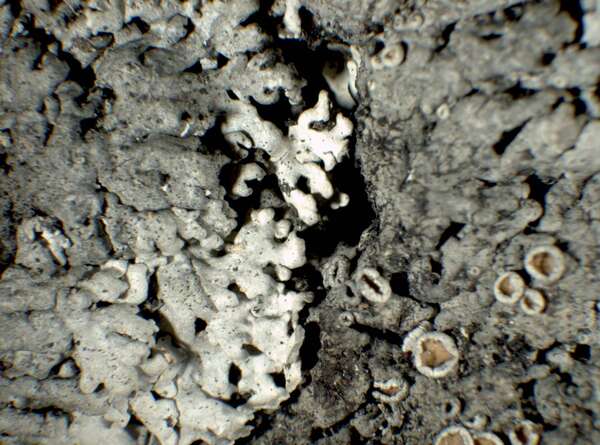

P.L. Nimis; Owner: Department of Life Sciences, University of Trieste
Herbarium: TSB (9466)
2001/12/18
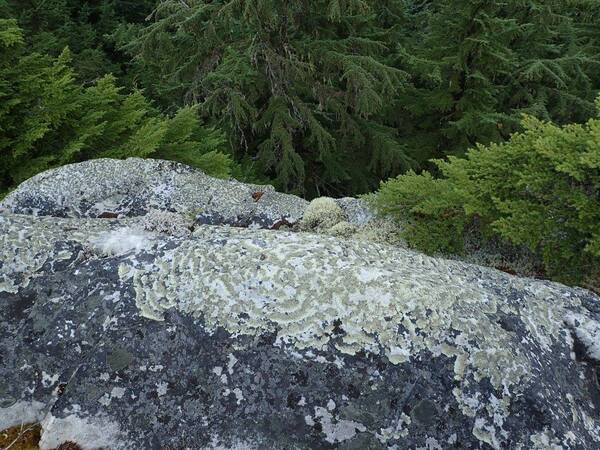

Curtis Randall Björk, - CC BY-SA 4.0
Sugarbowl-Grizzly Den Provincial Park, British Columbia, Canada
August 2017
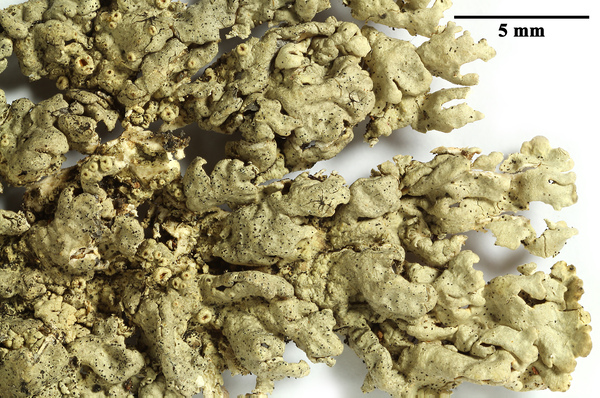

Felix Schumm - CC BY-SA 4.0
[20359], Bohemoslovacia, Bohemia merid., Vyšší Brod, in jugo montis Lu haud procul. p. Lipno, 820-850 m, ad saxa granitica soli exposita. Leg. Z. Cernohorský, J. Vezda et al., 30.09.1977. A. VEZDA: LICHENES SELECTI EXSICCATI NR. 1540
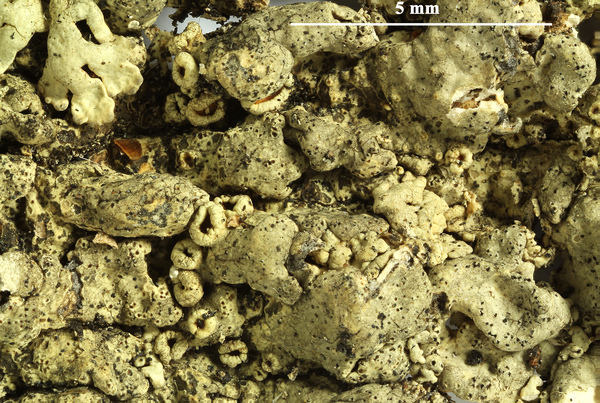

Felix Schumm - CC BY-SA 4.0
[20359], Bohemoslovacia, Bohemia merid., Vyšší Brod, in jugo montis Lu haud procul. p. Lipno, 820-850 m, ad saxa granitica soli exposita. Leg. Z. Cernohorský, J. Vezda et al., 30.09.1977. A. VEZDA: LICHENES SELECTI EXSICCATI NR. 1540
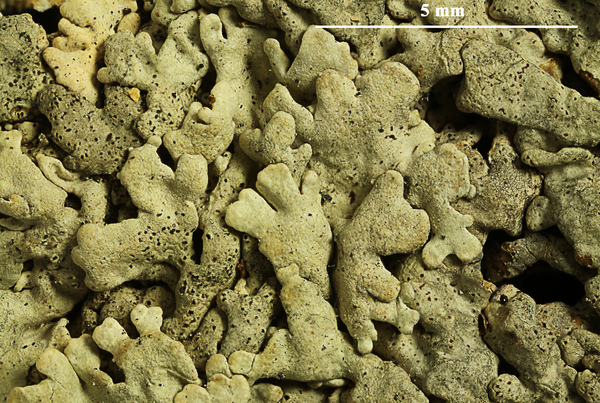

Felix Schumm - CC BY-SA 4.0
[20359], Bohemoslovacia, Bohemia merid., Vyšší Brod, in jugo montis Lu haud procul. p. Lipno, 820-850 m, ad saxa granitica soli exposita. Leg. Z. Cernohorský, J. Vezda et al., 30.09.1977. A. VEZDA: LICHENES SELECTI EXSICCATI NR. 1540
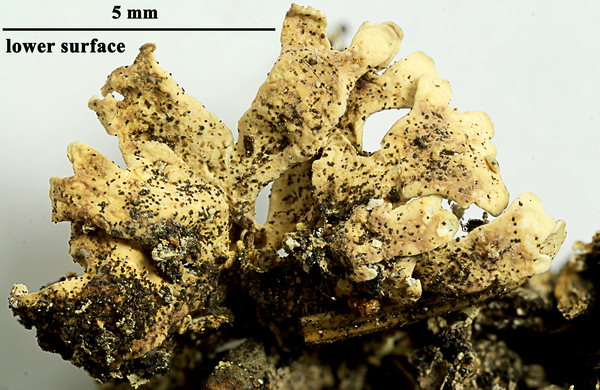

Felix Schumm - CC BY-SA 4.0
[20359], Bohemoslovacia, Bohemia merid., Vyšší Brod, in jugo montis Lu haud procul. p. Lipno, 820-850 m, ad saxa granitica soli exposita. Leg. Z. Cernohorský, J. Vezda et al., 30.09.1977. A. VEZDA: LICHENES SELECTI EXSICCATI NR. 1540
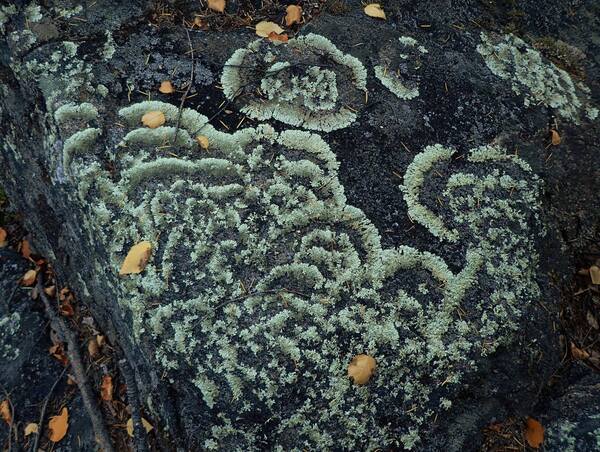

Curtis Randall Björk, - CC BY-SA 4.0
Grouse Creek Notch, above the house, British Columbia, Canada
05.10.2018
Growth form: Foliose, narrow lobed
Substrata: rocks
Photobiont: green algae other than Trentepohlia
Reproductive strategy: mainly sexual
Commonnes-rarity: (info)
Alpine belt: extremely rare
Subalpine belt: extremely rare
Oromediterranean belt: absent
Montane belt: absent
Submediterranean belt: absent
Padanian area: absent
Humid submediterranean belt: absent
Humid mediterranean belt: absent
Dry mediterranean belt: absent

Predictive model


P.L. Nimis; Owner: Department of Life Sciences, University of Trieste
Herbarium: TSB (9466)
2001/12/18


Curtis Randall Björk, - CC BY-SA 4.0
Sugarbowl-Grizzly Den Provincial Park, British Columbia, Canada
August 2017


Felix Schumm - CC BY-SA 4.0
[20359], Bohemoslovacia, Bohemia merid., Vyšší Brod, in jugo montis Lu haud procul. p. Lipno, 820-850 m, ad saxa granitica soli exposita. Leg. Z. Cernohorský, J. Vezda et al., 30.09.1977. A. VEZDA: LICHENES SELECTI EXSICCATI NR. 1540


Felix Schumm - CC BY-SA 4.0
[20359], Bohemoslovacia, Bohemia merid., Vyšší Brod, in jugo montis Lu haud procul. p. Lipno, 820-850 m, ad saxa granitica soli exposita. Leg. Z. Cernohorský, J. Vezda et al., 30.09.1977. A. VEZDA: LICHENES SELECTI EXSICCATI NR. 1540


Felix Schumm - CC BY-SA 4.0
[20359], Bohemoslovacia, Bohemia merid., Vyšší Brod, in jugo montis Lu haud procul. p. Lipno, 820-850 m, ad saxa granitica soli exposita. Leg. Z. Cernohorský, J. Vezda et al., 30.09.1977. A. VEZDA: LICHENES SELECTI EXSICCATI NR. 1540


Felix Schumm - CC BY-SA 4.0
[20359], Bohemoslovacia, Bohemia merid., Vyšší Brod, in jugo montis Lu haud procul. p. Lipno, 820-850 m, ad saxa granitica soli exposita. Leg. Z. Cernohorský, J. Vezda et al., 30.09.1977. A. VEZDA: LICHENES SELECTI EXSICCATI NR. 1540


 INDEX FUNGORUM
INDEX FUNGORUM
 GBIF
GBIF
 DOLICHENS
DOLICHENS
